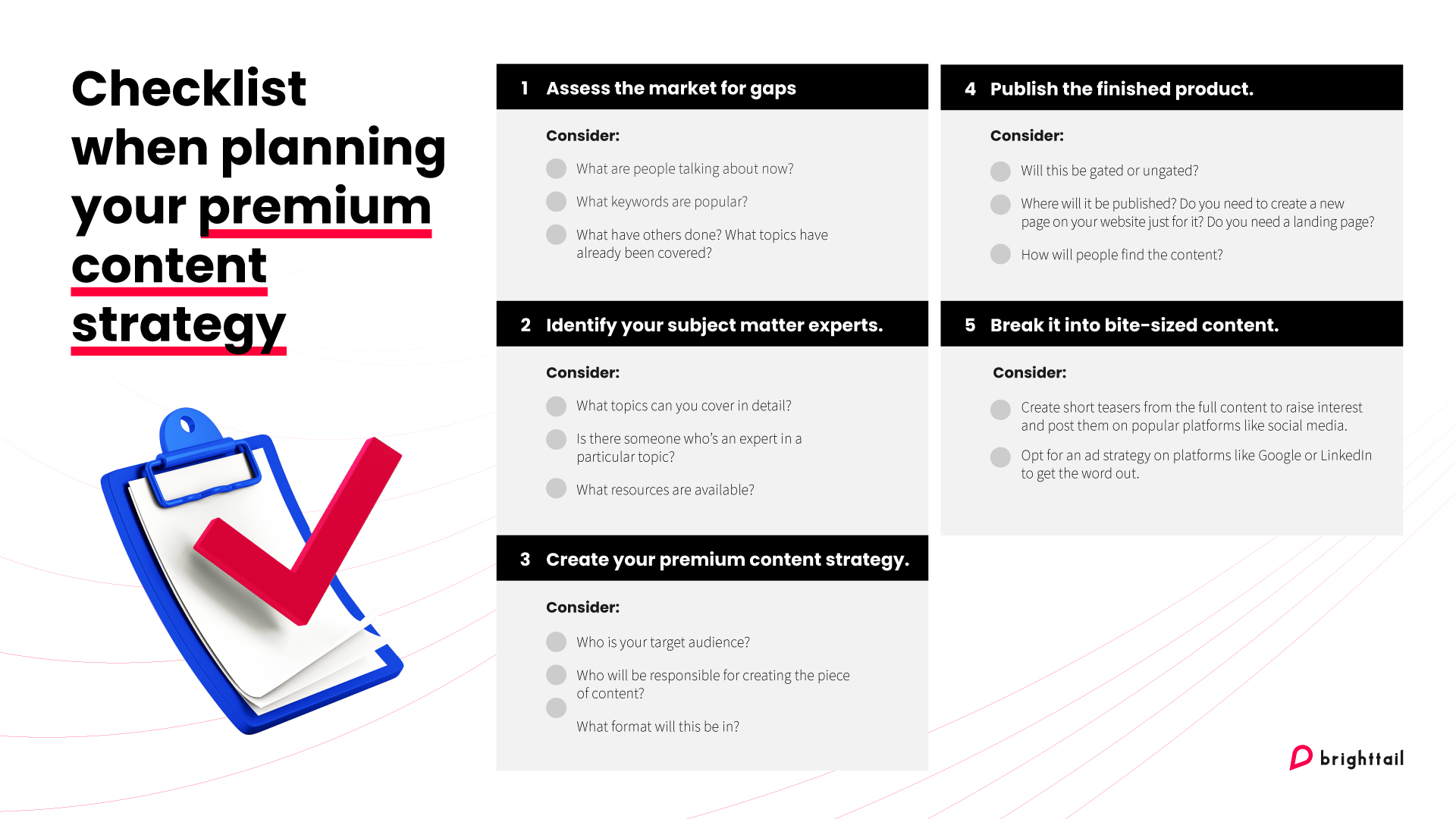Content is king. As a B2B marketer, you know full well the power and draw that well-crafted content can create. However, you’ve noticed that blog posts can only take you so far.
This is where premium content comes in. Premium content is designed to bridge the gap between awareness and consideration to turn casual readers into leads. It draws upon what is unique to your company – your experience, in-house expertise, and your company’s unique values – to create valuable content that stands out above the rest.
Here’s how you can turn your expertise into premium content.
Premium Content Definition and Examples
At its core, premium content is any content that adds more value than the basic blog posts and articles that currently dominate the web. It’s thought-provoking, persuasive and backed by research.
Rather than offering general advice, premium content goes a step further to offer bonus features such as detailed guides, downloadable resources, and access to exclusive events or information that boosts a company’s reputation and credibility in a reader’s mind.
Premium content comes in many different forms. Here are eight of the most popular and some linked examples of premium content that we’ve done for our clients.
- Pillar pages
Defined by HubSpot as “the basis on which a topic cluster is built,” pillar pages are a good example of ungated premium content that covers a given topic with links to more in-depth content. Think of them as signposts that give readers a solid overview of a subject as well as directions to where they can find more specific information if required. As long-form content that links to other pages on the website, they increase time spent on the site and pages visited, leading search engines to rank them higher than blog posts in search results. They’re an effective way to outrank competitors for highly competitive keywords. - E-books
Extremely portable and of relatively low cost to produce, e-books are one of the most popular forms of premium content as they act as a deep dive into a particular topic. Topics could include how-to guides, best practices and strategies, or insights from leading companies. They’re also most likely to be gated. - White papers
Designed to guide business decision-makers towards the right solution strategy, white papers are authoritative resources that require careful research to produce. An example is MegaChips’ white paper that proposes how to get around cost barriers and bandwidth bottlenecks when designing smart buildings. - Industry reports
Industry reports present a wider perspective on a particular topic, often focusing on industry trends or market outlooks. They are best employed by businesses in emerging categories to show the adoption of new approaches and technologies, as well as the benefits that leaders are experiencing from them. Some of the best reports use surveys to understand how industry players view the market such as this report on scaffolding technology by Avontus. - Case studies
Also called success stories, case studies serve as proof of how a product has made a positive change to a customer’s business. Case studies are best left ungated as they are one of the best ways to drive brand awareness and credibility. B2B marketers often see great results from integrating case studies into remarketing campaigns, bringing prospects back to the website to learn how other companies have benefited from their investment. - Webinars
Webinars take advantage of today’s live video technology to host presentations, workshops, and lectures online to a virtual audience. Unlike physical presentations, webinars can be attended by anyone with an internet connection and recorded for on-demand watching or repurposed into other content assets. - Demo videos
Demo videos provide a practical showcase of how a particular product or service works and what features are included. The best demo videos stir up interest and drive viewers to act, either by requesting a one-on-one demo or making a purchase. - Podcasts
No longer just for radio enthusiasts or content creators, podcasts require fewer resources to produce but can drive engagement for brands and build loyal audiences. Like webinars, they can also be repurposed into different content assets. Unlike webinars, these work best if ungated and available on public platforms like Spotify – in fact, the more popular the platform, the better.
Note: While it’s common for premium content to be gated – either locked behind a paywall or requiring readers to provide their contact details in exchange – it’s not necessary to do so. At Brighttail, we’ve seen success with a hybrid strategy, keeping some content gated while others like pillar pages and case studies are left open. This lowers engagement barriers but still allows us to obtain information from prospects.
Key Benefits of Premium Content
Rather than mainly driving traffic, premium content focuses on getting your target audience to act, either by requesting a demo or signing up for a product trial.
Here are the four major benefits of premium content.
- It positions you as a thought leader ahead of the market, not just a product vendor. You can literally become the company that wrote the book on a particular topic. Not only will this distinguish you from your competitors and position your company at the forefront of the industry, but others might also come to you for advice.
- It demonstrates expertise within your company. You don’t need to look far for subject matter experts. Capitalize on your existing talent – if you have someone on your team who has extensive experience or is an expert in their field, use their knowledge to create valuable content that is unique to you. But you don’t need your engineers to become writers. Good B2B marketing agencies can often write premium content based on a short sourcing session with your subject-matter experts.
- It deepens engagement. The best premium content is personal, for both you and your audience. By sharing your expertise with readers, it deepens a prospect’s understanding of your company and people. It’s also a good opportunity for you to reach out to your existing network. Ask them for their feedback and thoughts about current trends and turn their opinions into premium content.
- It expands your contact list. Premium content is valuable and likely to be shared across networks. As more people encounter your work, awareness of your company and the valuable content you create will grow and lead to new prospects. In addition, gated content is a good way to collect contact information that your sales or outreach team can use to engage prospects.
4 Steps to Creating Premium Content
Premium content needs to provide more value than just a simple blog post. It needs to provide clear answers to your audience’s burning questions without being overtly promotional or giving away proprietary information. Balancing the two is what makes premium content so valuable.
The key to creating great premium content starts with research. Here’s a step-by-step guide to getting you started.
- Understand your target audience. Every piece of content should be directed to a reader, so step back and think about who you want to target with this content. What topics are they interested in? What information are they looking for? Where and how do they prefer to consume content? Do they prefer reading e-books, or would they prefer watching a demo video instead? Some forms of content won’t work for your audience – you need to know which segments prefer a certain format and which don’t.
Tip: Start with a survey. Ask your target audience about any pain points or concerns they have and need answering. You can also turn this data into a strong, standalone content asset! - Know your own resources. Think about how you can provide value to your audience. Is there something different you can bring to the table? Is there a solution that you currently provide that no one else does? People don’t want to read the same ideas on the same subject; they would much rather read about something different that adds value.
You can also consider picking something you already have experience in. While it is possible to write on a topic that you’re only somewhat acquainted with, picking something that you are intimately familiar with will allow you to create better content that is truly unique to you.
Another thing to consider is your resources. Do you have sufficient resources and time to set aside to create in-depth content? If not, do you already have published content or existing resources that can be turned into premium content? - Create with a specific issue in mind. Once you have a good idea of what your audience is searching for and the knowledge you bring to the table, build your content around a question or a challenge your readers are facing.
Don’t just talk about yourself. While you should draw on your own experiences and expertise when writing premium content, the person you need to keep top of mind is your target audience. Focus on how you can use your knowledge to help them solve their challenges.
Tip: Find out what questions they’re asking. Dig through long-tail search terms, forums like Quora and Reddit, or online communities to discover key information gaps your audiences need to bridge. - Start with a strategy. A content strategy defines how your content will be used to achieve your marketing goals, and it’s even more important for premium content. Don’t forget to include a marketing strategy to create buzz around your new content.
Our premium content strategy at Brighttail starts with research, looking at what is being discussed within our client’s industries and which keywords are generating the most traffic on the web. This allows us to ensure that whatever content we create is relevant and of interest to our audience.
The second part of our strategy is resource planning –charting out the people involved from the writers and designers behind creating the content to the web developers and digital marketers responsible for distributing it, and the time it will take from start to finish.
If you’re unsure, here’s a checklist of questions you can ask yourself when planning your premium content strategy.

Is Premium Content Worth the Effort?
Yes. Premium content is a key asset in today’s B2B marketing toolkit. While premium content requires significantly more resources and time to produce, the benefits you gain make the investment worth it. We’ve seen incredible growth in traffic and lead generation for clients who have opted to include premium content in their campaigns, as well as a boost in reputation within the community.
If you’re unsure how to get started or lack the resources, consider engaging a marketing-as-a-service solution provider for support. Our team at Brighttail has extensive experience in creating premium content, from designing a working strategy to execution and finally getting it online. So reach out today.



